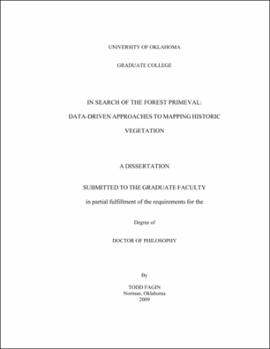| dc.contributor.advisor | Hoagland, Bruce W | |
| dc.creator | Fagin, Todd Daniel | |
| dc.date.accessioned | 2019-04-27T21:24:34Z | |
| dc.date.available | 2019-04-27T21:24:34Z | |
| dc.date.issued | 2009 | |
| dc.identifier | 9916295502042 | |
| dc.identifier.uri | https://hdl.handle.net/11244/318614 | |
| dc.description.abstract | Biogeography is the study of the spatial distribution of biota. It is a comparative and observational science that seeks to describe the variations in the spatial patterns of biodiversity through the examination of historical (e.g. vicariance, speciation, and extinction) and ecological (e.g. climate, edaphic, and topographic) factors. Additionally, researchers are increasingly recognizing the role that anthropogenic disturbance regimes have played in shaping current biogeographic patterns. Indeed, in many parts of the world, humans have become the dominant force in alterations to biotic distributions. Since human activities can influence biotic patterns for many years, the interpretation of biogeographic phenomenon without consideration of human influence may lead to erroneous conclusions. | |
| dc.description.abstract | This research is built upon the broad supposition that evaluation of current biogeographic patterns must be predicated on antecedent conditions, typically prior to widespread anthropogenic disturbance regimes. To this end, this research utilizes historical data to create baselines from which subsequent changes in biogeographic patterns can be measured. In a narrow sense, this dissertation focuses on land use, land cover, and woody plant compositional changes in the Arbuckle Mountains of south-central Oklahoma during a period of rapid demographic change (circa 1870 to 1898). In this regard, this research seeks to provide insight into the ecological processes of habitat fragmentation, woody plant encroachment, and mesophication that are believed to have occurred subsequent to the periods under investigation in this research. | |
| dc.description.abstract | In a broader context, this research is an evaluation of how anthropogenic alterations in landscape pattern and processes may affect the distributions of individual woody plant taxon. Though the datasets utilized in this research are unique to the region, the methods employed in this study should be transferable to other areas of interest. Additionally, the patterns and processes under investigation are not unique to the region under investigation. The results of this research, therefore, should be placed within the context of anthropogenic change that has occurred throughout the eastern deciduous forests of North America, particularly in the western cross timbers, in the period following European settlement. | |
| dc.description.abstract | In order to accomplish these goals, this dissertation is divided into two broad research themes. The first employs repeat Public Land Survey System (PLS) data from the 1870s and 1890s, respectively, to quantify changes in landscape structure, woody taxa assemblages, and anthropogenic markers in the Arbuckle Mountains during this period of rapid demographic transition. The second utilizes a Bayesian method known as weights-of-evidence to address the problem of coarse sampling structure of PLS records. The results of this research indicate that the landscape of the Arbuckle Mountains became increasingly fragmented during the approximately 27 years between the two surveys, primarily due to land clearance for agriculture, transportation networks, and anthropogenic structures. Additionally, there were changes in stand composition between the two surveys, implying that these anthropogenic disturbance regimes may be responsible for shifts in biogeographic patterns. The weights-of-evidence method proved to be a statistically valid method to map individual taxon distributions at finer resolutions than afforded from traditional methods of mapping PLS data. These findings will help further elucidate subsequent distributional shifts in these taxa, thereby providing a better understanding of contemporary biogeographic patterns. | |
| dc.format.extent | 219 pages | |
| dc.format.medium | application.pdf | |
| dc.language | en_US | |
| dc.relation.requires | Adobe Acrobat Reader | |
| dc.subject | Vegetation mapping | |
| dc.subject | Vegetation classification--Oklahoma--Arbuckle Mountains | |
| dc.subject | Plants--Biogeography | |
| dc.title | IN SEARCH OF THE FOREST PRIMEVAL: DATA-DRIVEN APPROACHES TO MAPPING HISTORIC VEGETATION | |
| dc.type | text | |
| dc.type | document | |
| dc.thesis.degree | Ph.D. | |
| ou.group | College of Atmospheric & Geographic Sciences::Department of Geography and Environmental Sustainability | |
